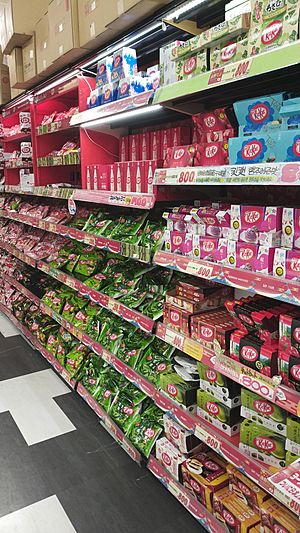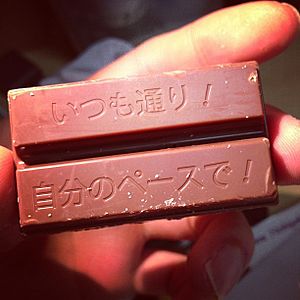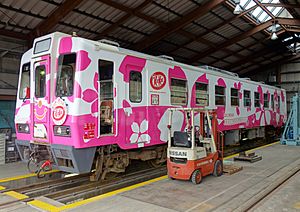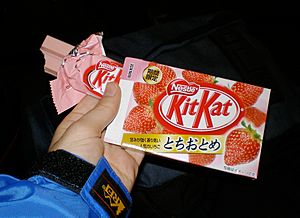Kit Kats in Japan facts for kids

Did you know that Japan has over 300 special flavors of Kit Kat chocolate bars? Many of these flavors are only found in Japan. Since 2000, these unique Kit Kats have become very popular. Nestlé, the company that makes Kit Kats in Japan, reported that Kit Kat was the best-selling candy there from 2012 to 2014. A clever marketing idea helped this success. Kit Kat teamed up with Japan Post to sell the bars in post offices. This campaign won an award in 2010. The name "Kit Kat" sounds like the Japanese phrase Kitto Katsu (きっと勝つ). This phrase means "You will surely win." Because of this, Kit Kats became a popular good luck charm. Students often send them to friends before important university exams.
Contents
The Story of Kit Kat in Japan
Kit Kats first came to Japan in 1973. A British candy company called Rowntree's partnered with a Japanese company named Fujiya. By 2014, Kit Kats were the most popular candy in Japan. They became the top seller in 2012, beating out Meiji chocolate.
Why So Many Flavors?
The famous green tea flavor was first made in 2004. Since then, over 300 different flavors have been created. In 2010, the soy sauce flavor was a top seller! Nestlé says these many flavors are popular because of a Japanese tradition called omiyage. This is when people bring back special gifts from places they visit. These gifts are often local foods for family and friends.
Making limited-edition flavors also helps the company. It makes the Kit Kats feel special and rare. This business idea also helped with how Japanese convenience stores work. These stores often change the items they sell. By making smaller batches of flavors, Nestlé could control how much it spent. It was also good for business because stores in Japan do not charge a fee to sell new products.
Kit Kats in Japan are made in Nestlé factories. These factories are located in Himeji and Kasumigaura. The chocolate is made from whole-milk powder. Most of the cacao beans come from West Africa.
How Kit Kat is Marketed
The marketing for Kit Kats in Japan has been very successful. This is partly because "Kit Kat" sounds like "Kitto Katsu". This Japanese phrase means "You will surely win." Many people connect Kit Kats with good luck. This is especially true for students taking exams. The "Lucky Charm" advertising campaign won an award in 2005.
Sending Good Luck
In 2009, Nestlé and Japan Post started a special campaign. People could buy Kit Kat bars and mail them from 20,000 post offices. These special packages had a space to write a message. You could write words of encouragement and send them like a postcard. All the special packages sold out in just one month. This campaign won a big award in 2010 at the Cannes Lions advertising festival.
Amazing Kit Kat Flavors
The Kit Kat Chocolatory is a special shop that opened in 2014. Chef Yasumasa Takagi creates the recipes for these high-end Kit Kats. By 2015, there were seven Chocolatory shops. These shops have served over 1 million customers. They have also earned a lot of money.
Unique and Special Flavors
These shops sell fancy Kit Kats. Some flavors include raspberry dark chocolate, orange-chocolate rum, cherry blossom, and green tea. Chef Takagi has also created seasonal flavors. These include plum, passion fruit, chili, ginger, and kinako soybean powder. In 2016, Nestlé even made a sake Kit Kat. It mixes sake powder with white chocolate.
Some Kit Kat flavors are only sold in certain regions of Japan. These flavors are linked to that specific area. Other flavors are made for a short time. Any extra bars are sometimes saved for special "happy bag" sales at the end of the year. In 2015, 500 special bitter chocolate bars were sold. They had gold leaf wrapping and cost about $16 each.
Some well-known flavors are adzuki (red bean), beni imo (purple sweet potato), brown sugar syrup, matcha (green tea), and soy sauce.
Kit Kat in Other Foods
Some cafes have even added Kit Kats to their croissants. In March 2014, pizza places like Napoli no Kama and Strawberry Cones made dessert pizzas. These pizzas had bakeable Kit Kat toppings!
In October 2018, Nestlé opened a Kit Kat store at Namba Station in Osaka.
More Kit Kat Flavors
- Apple
- Amazake
- Baked potato
- Banana
- Black tea
- Blueberry cheesecake
- Brown sugar syrup
- Butter
- Café au lait
- Cantaloupe
- Cappuccino
- Cherry
- Cherry blossom green tea latte
- Chestnut
- Chocobanana
- Cinnamon cookie
- Corn
- Crème brûlée
- Edamame
- Fruit parfait
- Ginger ale
- Green bean
- Hōjicha
- Hokkaido cheese and chocolate
- Hokkaido melon with mascarpone cheese
- Hokkaido roasted corn
- Hot Japanese chili
- Kinako
- Lemon cheesecake
- Maple
- Melon and cheese
- Miso soup
- Muscat of Alexandria
- Okinawa sweet potato
- Oreo ice cream
- Pear
- Pineapple
- Pumpkin
- Ramune soda
- Raspberry passionfruit
- Red potato
- Rock salt
- Royal milk tea
- Ruby chocolate
- Sake
- Salt and caramel
- Shikuwasa
- Soy flour
- Soy sauce
- Strawberry
- Strawberry cheesecake
- Sweet pudding
- Tokyo Banana
- Triple berry swirl
- Vegetable juice
- Wasabi
- Watermelon
- Yūbari melon
- Yuzu
See also
- Omiyage
- Meibutsu




